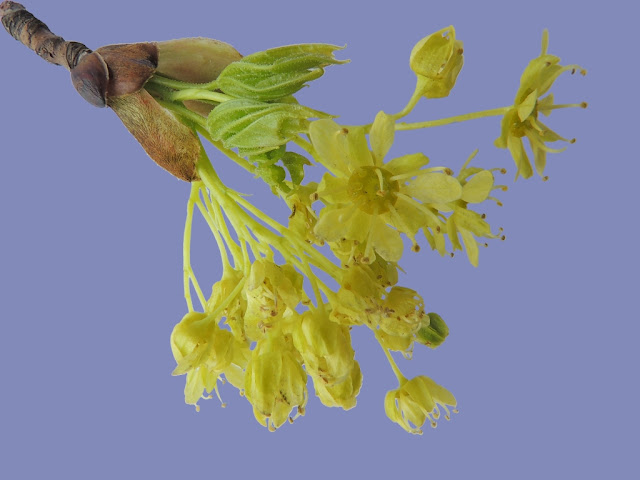In the Norway Maple they appear from March to April and can be numerous enough to make the tree look like it actually has leaves. I find the flowers attractive and the whole flower is yellow, including the flower stalks.
The flowers are in a cluster known as a corymb. This is where the flower stalks grow longer and try to ensure a flat-topped structure - with all the flowers forming a flat or slightly convex heard.
This is very similar, on the face of it, to another type of inflorescence called an umbel (think cow parsley). The main difference between the corymb and an umbel, seems to be that the flower stalks leave the stem at different points to form a corymb, whereas on an umbel all the flower stalks come from a common point on the stem.
These trees are tolerant of poor soils and can reach around 4 metres in 3 years. As the tree matures, the growth rate slows down. All of which, makes it a good tree for urban places, in my humble opinion.
The timber of the Norway maple is similar to that of sycamore and both are popular for making furniture. They are easy to work, making them ideal for mouldings as well as turning. However, they don't taint food, which makes them ideal for chopping boards and kitchen utensils.
I was amazed to see just how many cultivars of the Norway maple there are. But when you look at the different leaves, from variegated to brown, from deeply lobed to almost fern-like - as well as the different tree shapes, I can see that each of the around 90 cultivars are diverse enough to be enjoyed for different reasons and used in nearly all situations.
I imagine that wherever you are in Europe or North America, there's a Norway maple near you - have you spotted it yet!?
Sources:
Coombes, Allen J., and Zsolt Debreczy. The Book of Leaves: A Leaf-by-Leaf Guide to Six Hundred of the World’s Great Trees. S.l.: Ivy Press, 2015.
Hemery, Gabriel, and Sarah Simblet. The New Sylva: A Discourse of Forest and Orchard Trees for the Twenty-First Century. London: Bloomsbury Publishing, 2014.
Inflorescences. 2016. Inflorescences. [ONLINE] Available at: http://theseedsite.co.uk/inflorescences.html. [Accessed 21 June 2016].
More, David, and John White. Illustrated Trees of Britain and Northern Europe. London, UK: A&C Black, 2012.


Is the last photo stacked? I think it must be, with such fantastic detail! I may have to invest. Does it take long to create such photos?
ReplyDeleteHi Hollis, yep, that one is stacked. The whole process is so easy. As mentioned in a previous post, I use Helicon Focus. When you've taken your images, just import your photos and click 'run'. Depending on the amount of photos you've taken it might take a few minutes to finish the run. There are 3 different stacking methods to choose from, so if you're not happy with the results of one method, then you can choose another. There is also the ability to retouch the finished stack, which comes in useful as my camera doesn't have a great manual focus.
DeleteI definitely find stacking rewarding - I find it easy and normally get instant results. I hope that's helpful to you.